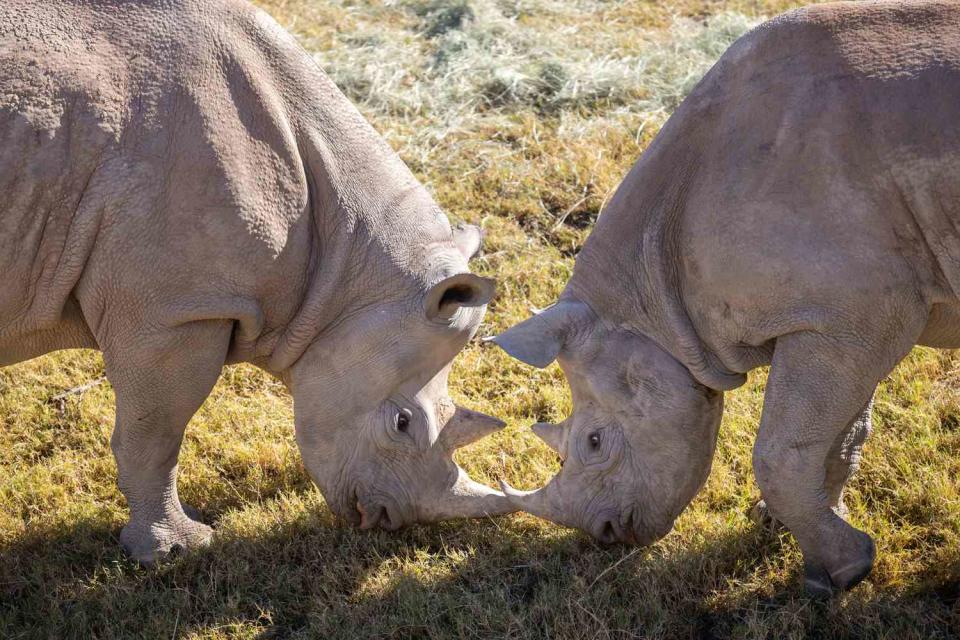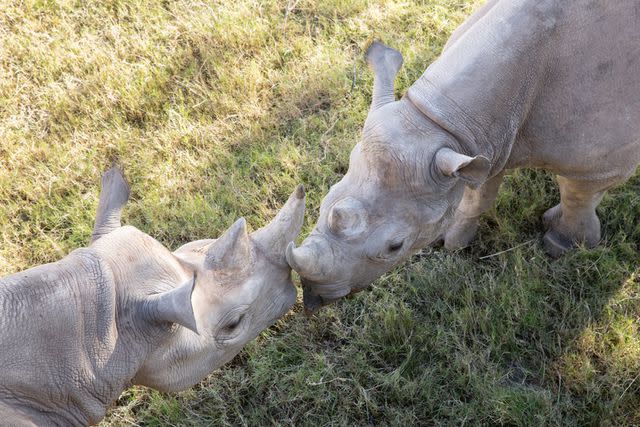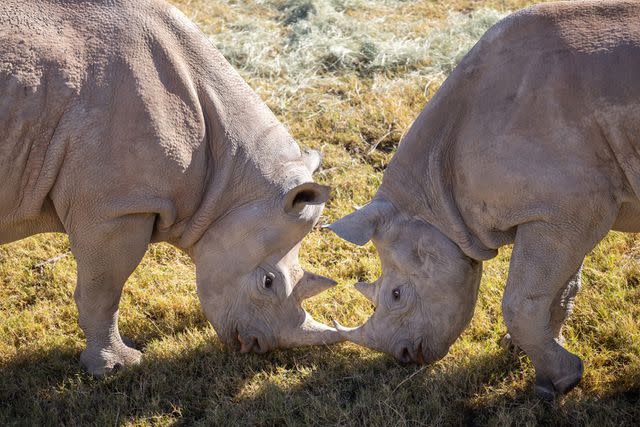Rhino Born on Christmas Eve Finds Love at California Zoo with Help from Matchmakers (Exclusive)
Jaali the black rhino met his potential mate recently at The Living Desert Zoo and Gardens after two years of waiting

The Living Desert Zoo and Gardens
Black rhinos Nia and Jaali during one of their "dates" at The Living Desert Zoo and GardensJaali the black rhino has plenty to be jolly about this holiday season.
The soon-to-be 4-year-old rhino was born on Christmas Eve 2019 at the Potter Park Zoo in Lansing, Michigan. In 2021, the endangered animal was moved to The Living Desert Zoo and Gardens in Palm Desert, California, on a breeding recommendation from the Association of Zoo and Aquariums' Species Survival Plan (SSP).
Nia, a black rhino from the Cleveland Zoo, was also moved to The Living Desert Zoo around the same time to be Jaali's potential mate as part of the same breeding recommendation.
"The SSP coordinator, I always joke; it's a little bit like a combination of ancestry.com and Tinder. They make recommendations. They know that this female and this male are underrepresented genetically in the population and need to get together," Allen Monroe, the president and CEO of The Living Desert Zoo and Gardens, tells PEOPLE.
"They both have Swahili names. Nia means purposeful in Swahili. She's five years old and came to us from the Cleveland Zoo. Jaali will turn four years old on Christmas Eve. His name Jaali (pronounced like jolly) means powerful in Swahili," Monroe continues, adding that Jaali's name likely has a dual purpose given the rhino's Christmas Eve birthday.
Related: Baby African Elephant Born at Disney’s Animal Kingdom for the First Time in 7 Years
While both animals relocated to the California zoo in 2021, they had to wait until they reached sexual maturity to meet officially. The pair's first dates started in 2023, and the courtship is off to a strong start so far.
"Our habitat was designed very specifically to meet all the needs of the rhino, so there are lots of special features that are built into it. One of which is that the habitat can be divided into two halves," Monroe explains of the rhinos, the first to live at The Living Desert Zoo.
"Black rhinos are solitary by nature. The general thought is that absence makes the heart grow fonder. So we had Jaali on one side of the habitat and Nia on the other. They can see each other. They can smell each other. We also switch them back and forth, so it's a little bit of a 'Who's been sleeping in my bed sort of thing,'" he adds.

The Living Desert Zoo and Gardens
The Living Desert Zoo continued to have the rhinos switch sides over the last two years, so the animals knew "that there's another black rhino in the area."
Two months ago, after reaching sexual maturity, Nia and Jaali found out who that rhino was by meeting face-to-face for the first time.
"We had this magical moment where we opened the gates, and one walked into the other side of the habitat, and that's when we started to see the first signs of rhino courtship take place," Monroe says.
During the first meeting, the rhinos approached one another and touched horns — a moment that looked like a sweet smooch but was really "a test of strength between the two," according to Monroe.
"It's a little like two bulldozers pushing back and forth against each other. Nia is trying to make sure that Jaali's up to snuff and has the strength and the good genes to pass along to her offspring. So they spent about a half an hour of this sort of sumo wrestling back and forth," he adds of the rhino's introduction.
Jaali, Nia, and The Living Desert Zoo are taking it slow regarding rhino romance. The two black rhinos still live in separate habitats, meeting when the moment is right for Nia.
"Rhino females have a relatively short reproductive period. It's only about three days out of the month, give or take. Nia's ovulation cycle is every 25 to 30 days. We can tell when she's approaching that both by her activity and Jaali's interest in her, so we try and time their introductions for that peak on breeding time," Monroe says.
The rhinos usually have a meeting each day of Nia's breeding window. Those dates often include some of the "sumo wrestling" Monroe previously mentioned, followed by a trot around the habitat and then a wallow in the mud to cap things off.
After that, "they go back to their two different sides of the habitat. Then we try it again the next day and the next day after that. Then we'll wait another month until we put them back together again," Monroe explains of the rhino courtship process.
"If they were put together all the time, then they're going to wear each other out. Jaali's going to chase Nia pretty regularly, and we don't want that to happen. These are large animals, so they can physically damage each other if they get frustrated. So we try and manage their, we call them dates. It's not the appropriate term, but it's a human corollary that makes sense," he adds.
Related: 3 Orphaned Mountain Lion Cubs Find New Home at San Diego Zoo After Week-Long Rescue
No attempts at breeding have occurred between the two rhinos yet, but The Living Desert Zoo is still overjoyed at the progress this rhino relationship has made so far.
"It's been amazing for us to see this first step of the rhino courtship between Jaali and Nia. We've been working for more than four years to get to this point. We spent a year designing this habitat with our zoo architects and another year of construction. Then, there were two years of waiting for Jaali and Nia to reach reproductive age. It's heartwarming to see them go through this courtship." Monroe says.

The Living Desert Zoo and Gardens
These rhino dates aren't for keepers' eyes only; the meet-ups happen "in full view of the public," so zoo guests can watch Jaali and Nia's progress as a couple, too. But Monroe acknowledges that visitors shouldn't expect an epic love story just yet.
"We expect it could take six to 12 months for there to be a successful copulation and pregnancy. They're using hormones and natural instinct to determine what's going on and what they need to do. So we have our fingers crossed, but we realistically expect it'll take a while," Monroe says, adding that rhinos have a 15-month gestation period, so "a little baby rhino is probably realistically at least three years away."
Never miss a story — sign up for PEOPLE's free daily newsletter to stay up-to-date on the best of what PEOPLE has to offer, from juicy celebrity news to compelling human interest stories.
Monroe hopes that being able to watch these rhinos interact inspires guests to protect these animals,
"Only about 6,000 black rhinos are left on the planet right now. That's an incredibly small number. It's all due strictly to human greed and avarice," he says. "It's from that desire to own a souvenir from a black rhino, that beautiful horn. It's a rhino's Swiss army knife. They use it for all sorts of things. To defend themselves, to dig holes. Jaali and Nia like to use it as a Ginsu knife to chop open pumpkins and watermelons, for instance."
"The more people who have people connections with these rhinos, the more people will tell their friends and neighbors and share the message that black rhinos are in danger and it's all because of human activity," Monroe adds.
For more People news, make sure to sign up for our newsletter!
Read the original article on People.

